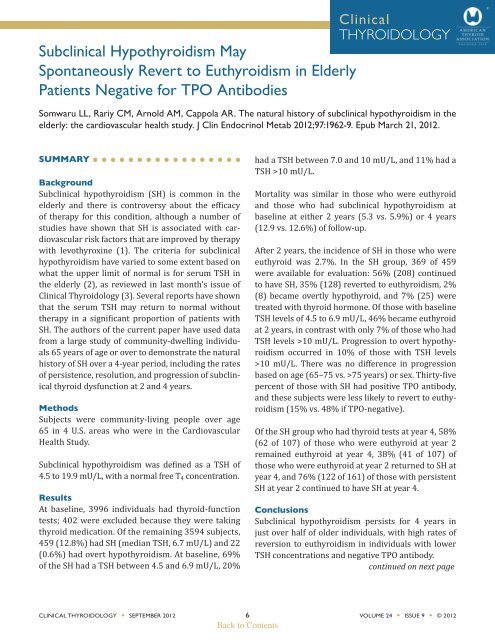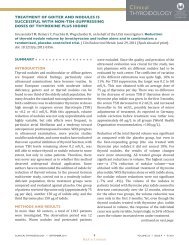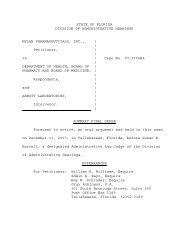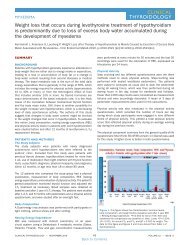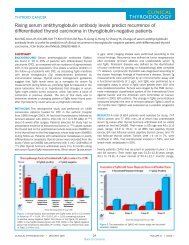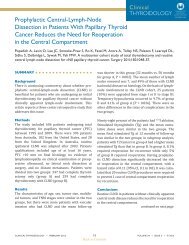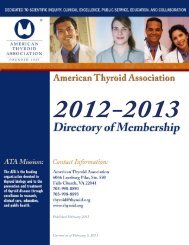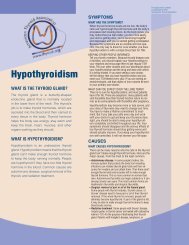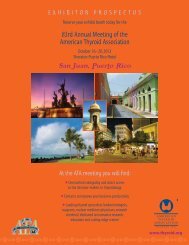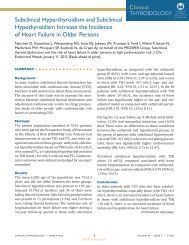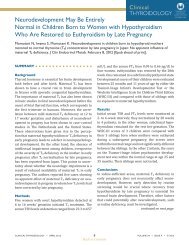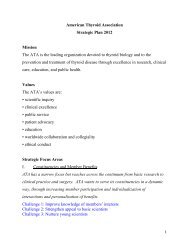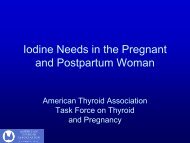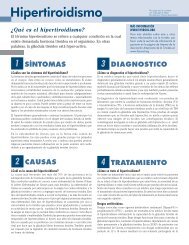Subclinical Hypothyroidism May Spontaneously Revert to ...
Subclinical Hypothyroidism May Spontaneously Revert to ...
Subclinical Hypothyroidism May Spontaneously Revert to ...
You also want an ePaper? Increase the reach of your titles
YUMPU automatically turns print PDFs into web optimized ePapers that Google loves.
ClinicalTHYROIDOLOGY<strong>Subclinical</strong> <strong>Hypothyroidism</strong> <strong>May</strong><strong>Spontaneously</strong> <strong>Revert</strong> <strong>to</strong> Euthyroidism in ElderlyPatients Negative for TPO AntibodiesSomwaru LL, Rariy CM, Arnold AM, Cappola AR. The natural his<strong>to</strong>ry of subclinical hypothyroidism in theelderly: the cardiovascular health study. J Clin Endocrinol Metab 2012;97:1962-9. Epub March 21, 2012.SUMMARYBackground<strong>Subclinical</strong> hypothyroidism (SH) is common in theelderly and there is controversy about the efficacyof therapy for this condition, although a number ofstudies have shown that SH is associated with cardiovascularrisk fac<strong>to</strong>rs that are improved by therapywith levothyroxine (1). The criteria for subclinicalhypothyroidism have varied <strong>to</strong> some extent based onwhat the upper limit of normal is for serum TSH inthe elderly (2), as reviewed in last month’s issue ofClinical Thyroidology (3). Several reports have shownthat the serum TSH may return <strong>to</strong> normal withouttherapy in a significant proportion of patients withSH. The authors of the current paper have used datafrom a large study of community-dwelling individuals65 years of age or over <strong>to</strong> demonstrate the naturalhis<strong>to</strong>ry of SH over a 4-year period, including the ratesof persistence, resolution, and progression of subclinicalthyroid dysfunction at 2 and 4 years.MethodsSubjects were community-living people over age65 in 4 U.S. areas who were in the CardiovascularHealth Study.<strong>Subclinical</strong> hypothyroidism was defined as a TSH of4.5 <strong>to</strong> 19.9 mU/L, with a normal free T 4 concentration.ResultsAt baseline, 3996 individuals had thyroid-functiontests; 402 were excluded because they were takingthyroid medication. Of the remaining 3594 subjects,459 (12.8%) had SH (median TSH, 6.7 mU/L) and 22(0.6%) had overt hypothyroidism. At baseline, 69%of the SH had a TSH between 4.5 and 6.9 mU/L, 20%had a TSH between 7.0 and 10 mU/L, and 11% had aTSH >10 mU/L.Mortality was similar in those who were euthyroidand those who had subclinical hypothyroidism atbaseline at either 2 years (5.3 vs. 5.9%) or 4 years(12.9 vs. 12.6%) of follow-up.After 2 years, the incidence of SH in those who wereeuthyroid was 2.7%. In the SH group, 369 of 459were available for evaluation: 56% (208) continued<strong>to</strong> have SH, 35% (128) reverted <strong>to</strong> euthyroidism, 2%(8) became overtly hypothyroid, and 7% (25) weretreated with thyroid hormone. Of those with baselineTSH levels of 4.5 <strong>to</strong> 6.9 mU/L, 46% became euthyroidat 2 years, in contrast with only 7% of those who hadTSH levels >10 mU/L. Progression <strong>to</strong> overt hypothyroidismoccurred in 10% of those with TSH levels>10 mU/L. There was no difference in progressionbased on age (65–75 vs. >75 years) or sex. Thirty-fivepercent of those with SH had positive TPO antibody,and these subjects were less likely <strong>to</strong> revert <strong>to</strong> euthyroidism(15% vs. 48% if TPO-negative).Of the SH group who had thyroid tests at year 4, 58%(62 of 107) of those who were euthyroid at year 2remained euthyroid at year 4, 38% (41 of 107) ofthose who were euthyroid at year 2 returned <strong>to</strong> SH atyear 4, and 76% (122 of 161) of those with persistentSH at year 2 continued <strong>to</strong> have SH at year 4.Conclusions<strong>Subclinical</strong> hypothyroidism persists for 4 years injust over half of older individuals, with high rates ofreversion <strong>to</strong> euthyroidism in individuals with lowerTSH concentrations and negative TPO antibody.continued on next pageCLINICAL THYROIDOLOGY • SEPTEMBER 2012 6 VOLUME 24 • ISSUE 9 • © 2012Back <strong>to</strong> Contents
<strong>Subclinical</strong> <strong>Hypothyroidism</strong> <strong>May</strong> <strong>Spontaneously</strong> <strong>Revert</strong><strong>to</strong> Euthyroidism in Elderly Patients Negativefor TPO AntibodiesSomwaru LL, et al.ANALYSIS AND COMMENTARYThis is the largest study of an elderly cohort thatexamined the natural his<strong>to</strong>ry of subclinical hypothyroidism.The conclusions are likely <strong>to</strong> be valid eventhough for about 10% of the SH group sera was notavailable for testing at 2 years. The results are similar<strong>to</strong> the Spanish study of 107 patients over 55 years ofage who had SH (4) that reported 37% of patientsreverted <strong>to</strong> a euthyroid state during a follow-up of 6months <strong>to</strong> 6 years; they also found that progression <strong>to</strong>overt hypothyroidism was related <strong>to</strong> the height of thebaseline serum TSH.In regard <strong>to</strong> therapy for SH, these data providesome reassurance that the current clinical practiceof treating those with TSH levels >10 mU/L andpositive anti-TPO is reasonable because thesepatients are much more likely <strong>to</strong> progress <strong>to</strong> overthypothyroidism.Would the results be different if the upper limit ofserum TSH was age-adjusted? If the upper TSH limitwas in the range of 5 <strong>to</strong> 6 mU/L, then the populationof those with SH would be smaller, especially thegroup with TSH levels of 4.5 <strong>to</strong> 6.9 mU/L who had thehighest reversion <strong>to</strong> normal. Regardless of the cu<strong>to</strong>fffor classification, those with mild elevations of serumTSH need <strong>to</strong> be retested before they are consigned <strong>to</strong>long-term therapy with levothyroxine. Another studyby the Spanish group showed that a large majority ofthe normalization of the serum TSH occurred withinthe first 2 years of follow-up (5), a finding that is consistentwith the current study.— Jerome M. Hershman, MDReferences1. Biondi B, Cooper DS. The clinical significanceof subclinical thyroid dysfunction. Endocr Rev2008;29:76-131. Epub November 8, 2007.2. Boucai L, Hollowell JG, Surks MI. An approachfor development of age-, gender-, and ethnicityspecificthyrotropin reference limits. Thyroid2011; 21: 5-11. Epub November 8, 2010.3. Kahapola-Arachchige KM, Hadlow N, WardropR, Lim EM, Walsh JP. Age specific TSH referenceranges have minimal impact on the diagnosis ofthyroid dysfunction. Clin Endocrinol (Oxf). June15, 2012 [Epub ahead of print]. doi:10.1111/j.1365-2265.2012.04463.x4. Díez JJ, Iglesias P. Spontaneous subclinicalhypothyroidism in patients older than 55 years:an analysis of natural course and risk fac<strong>to</strong>rsfor the development of overt thyroid failure.J Clin Endocrinol Metab 2004;89:4890-7.5. Díez JJ, Iglesias P, Burman KD. Spontaneousnormalization of thyrotropin concentrationsin patients with subclinical hypothyroidism.J Clin Endocrinol Metab 2005;90:4124-7.Epub April 5, 2005.CLINICAL THYROIDOLOGY • SEPTEMBER 2012 7 VOLUME 24 • ISSUE 9 • © 2012Back <strong>to</strong> Contents


